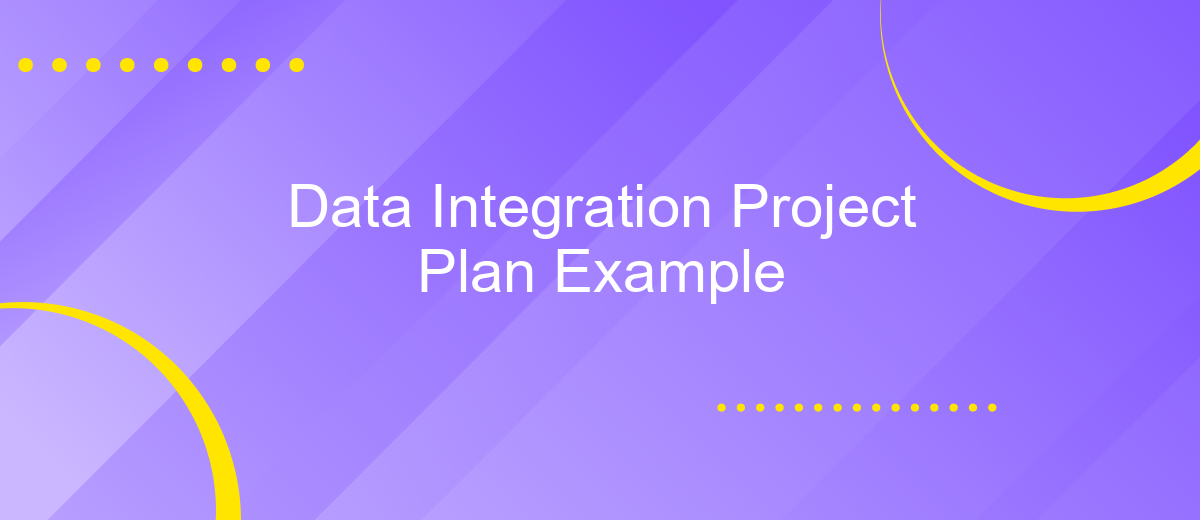Data Integration Project Plan Example
In today's data-driven world, effective data integration is crucial for organizations to harness the full potential of their information assets. This article provides a comprehensive example of a Data Integration Project Plan, outlining key steps and best practices. Whether you're a seasoned professional or new to the field, this guide aims to streamline your data integration efforts and ensure project success.
Executive Summary
The Data Integration Project Plan outlines the strategic approach for seamlessly integrating various data sources within an organization. This plan is designed to ensure data consistency, accuracy, and accessibility across all departments, ultimately enhancing decision-making processes and operational efficiency.
- Identify key data sources and their respective data owners.
- Establish data integration requirements and objectives.
- Select appropriate data integration tools and technologies, such as ApiX-Drive, to automate and streamline the integration process.
- Develop a detailed implementation timeline and assign responsibilities.
- Conduct thorough testing and validation to ensure data integrity and performance.
- Provide training and support to end-users for effective utilization of integrated data.
By leveraging advanced tools like ApiX-Drive, this project plan aims to minimize manual efforts, reduce errors, and facilitate real-time data synchronization. Successful execution of this plan will empower the organization with a unified data landscape, driving better insights and fostering a data-driven culture.
Project Objectives

The primary objective of this Data Integration Project is to seamlessly consolidate data from multiple sources into a unified system, ensuring data accuracy, consistency, and accessibility. By integrating disparate data sets, we aim to enhance data-driven decision-making processes, streamline operations, and improve overall business intelligence. This project will focus on minimizing data redundancy, eliminating data silos, and providing a single source of truth for all stakeholders.
Another critical goal is to implement scalable and flexible integration solutions that can adapt to evolving business needs. Utilizing tools like ApiX-Drive, we will automate data workflows, reduce manual data entry, and ensure real-time data synchronization across various platforms. This will not only save time and resources but also reduce the risk of human error. By leveraging ApiX-Drive’s capabilities, we aim to create a robust and efficient data integration framework that supports future growth and innovation.
Scope

The scope of this Data Integration Project Plan encompasses the comprehensive integration of multiple data sources into a unified system. This project aims to streamline data flow, enhance data accessibility, and improve overall data management efficiency by leveraging advanced integration tools and methodologies.
1. Identify and document all relevant data sources and endpoints.
2. Utilize ApiX-Drive to facilitate seamless data integration and automate data transfer processes.
3. Establish data mapping and transformation rules to ensure consistency and accuracy.
4. Implement data validation and quality checks to maintain data integrity.
5. Develop a monitoring framework to track integration performance and troubleshoot issues.
By integrating disparate data sources through a well-structured plan, we aim to create a cohesive data environment that supports informed decision-making. The use of ApiX-Drive will be instrumental in automating workflows and reducing manual intervention, thereby ensuring a more efficient and reliable data integration process.
Project Timeline and Milestones

The project timeline for the Data Integration Project is designed to ensure a structured and efficient approach to achieving our integration goals. We will follow a phased approach, with each phase building upon the previous one to ensure seamless data flow and integration across systems.
Initially, we will conduct a detailed requirements analysis to understand the data sources, integration needs, and desired outcomes. This will be followed by the selection of appropriate tools and platforms, such as ApiX-Drive, to facilitate the integration process.
- Phase 1: Requirements Analysis and Planning (Weeks 1-2)
- Phase 2: Tool Selection and Setup (Weeks 3-4)
- Phase 3: Data Mapping and Integration Development (Weeks 5-8)
- Phase 4: Testing and Validation (Weeks 9-10)
- Phase 5: Deployment and Monitoring (Weeks 11-12)
By adhering to this timeline and meeting the outlined milestones, we aim to achieve a robust and efficient data integration solution. Regular progress reviews and adjustments will be made to ensure the project stays on track and meets all objectives.
- Automate the work of an online store or landing
- Empower through integration
- Don't spend money on programmers and integrators
- Save time by automating routine tasks
Methodology and Technical Approach
The methodology for our data integration project is centered around a systematic approach that ensures seamless data flow between disparate systems. We start with a thorough analysis of the existing data sources and their respective formats. This is followed by the design of a robust data mapping strategy to ensure compatibility and consistency. We employ ETL (Extract, Transform, Load) processes to extract data from various sources, transform it into a standardized format, and load it into the target system. Regular data validation and quality checks are integrated into each phase to maintain data integrity and accuracy.
Our technical approach leverages modern integration platforms, with ApiX-Drive being a key component. ApiX-Drive facilitates the automation of data transfer between applications without the need for extensive coding, thus accelerating the integration process. It supports a wide range of applications and provides real-time synchronization, which is crucial for maintaining up-to-date information across systems. By utilizing ApiX-Drive, we can minimize manual intervention and reduce the risk of errors, ensuring a more efficient and reliable data integration solution.
FAQ
What is a Data Integration Project Plan?
Why is data integration important for businesses?
What are the key components of a Data Integration Project Plan?
How do you ensure data quality during the integration process?
What tools can be used for automating data integration tasks?
Apix-Drive is a simple and efficient system connector that will help you automate routine tasks and optimize business processes. You can save time and money, direct these resources to more important purposes. Test ApiX-Drive and make sure that this tool will relieve your employees and after 5 minutes of settings your business will start working faster.


